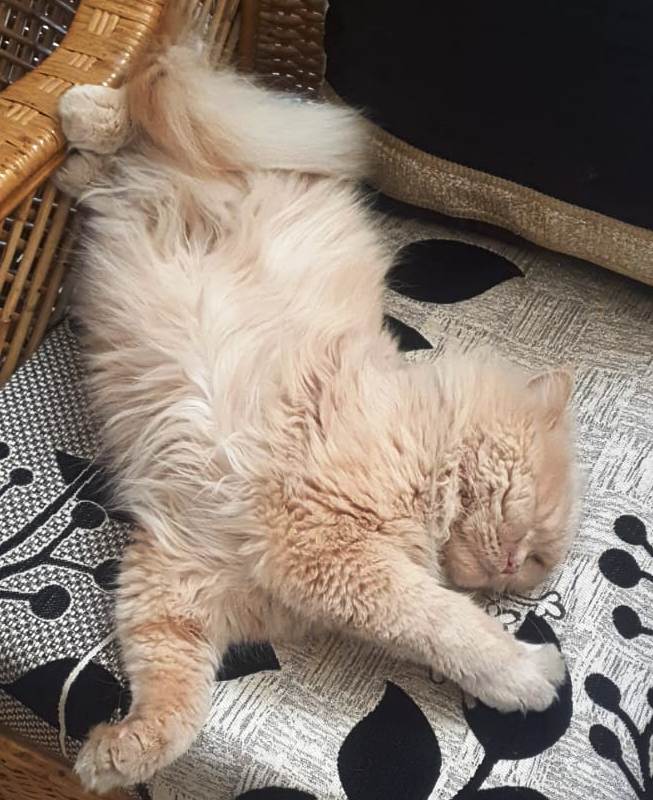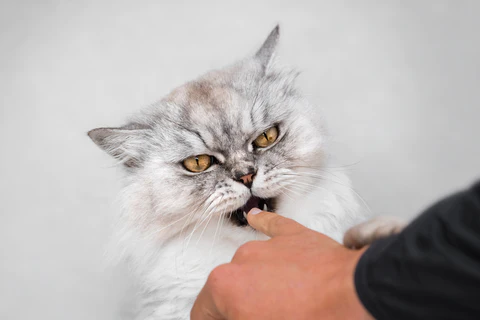Train your cat to perform tasks and tricks, and improve their emotional and mental health with our comprehensive guide. Discover tips and resources for effective feline training.
How To Train A Cat determining What You Want to Teach Your Cat?
How To Train A Cat by identifying what you want your cat to learn, whether it’s correcting unwanted behavior like scratching or teaching them new tricks like a high five. Once you’ve established your goals, you can create a training plan tailored to your cat’s needs. Common cat training objectives include litter box training, discouraging scratching and biting, and teaching commands such as sit, stay, and roll over. You can even train your cat to walk on a leash and learn new tricks.
- Encouraging positive socialization with people and other pets
- Helping a cat overcome anxiety or fear-related behaviors
- Teaching a cat to enjoy being groomed or handled for veterinary exams
- Training a cat to stay off of countertops or other areas
- Redirecting a cat’s attention from destructive behavior to appropriate play
- Improving a cat’s confidence and independence through agility training or other activities.
How To Train A Cat Training Techniques and Tools
Clicker and Treat Training for Cats
Clicker and treat training is a popular method for training cats that involves the use of a clicker and rewards. The clicker is a small device that makes a distinct sound when pressed, which serves as a marker for a desired behavior. The treat is a reward that the cat receives immediately after hearing the clicker sound, reinforcing the behavior that led to the click.
In clicker and treat training, the trainer begins by clicking the clicker and immediately giving the cat a treat. This helps the cat associate the sound of the click with the treat. Once the cat has made this association, the trainer can begin using the clicker to mark desired behaviors, such as sitting or coming when called. When the cat performs the desired behavior, the trainer clicks the clicker and gives the cat a treat, reinforcing the behavior.
Clicker and treat training can be used to teach a variety of behaviors, from basic obedience commands to more advanced tricks. It can also be helpful in addressing behavioral issues, such as aggression or anxiety. It is important to use high-quality treats that the cat finds rewarding, and to avoid overfeeding the cat during training sessions. Consistency and patience are key to success with clicker and treat training.
How To Train A Cat Shortening Training Sessions
Shortening training sessions refers to the practice of keeping training sessions with your cat brief and focused. This is important because cats have short attention spans and can quickly become bored or disinterested in training if the sessions are too long.
To keep training sessions short, start with just a few minutes at a time and gradually increase the duration as your cat becomes more comfortable with the training process. It’s also important to end the session on a positive note, with your cat successfully completing a task or receiving a reward.
By keeping training sessions short and focused, you can help your cat learn new behaviors and tricks while also preventing them from becoming overwhelmed or stressed. This can make the training process more enjoyable for both you and your feline companion.

Concentrating on a Single Objective at a Time
When training your cat, it’s important to focus on one objective at a time. This means that you should not overwhelm your cat by trying to teach them multiple commands or tricks at once. Instead, choose a specific behavior or task that you want to work on and concentrate on that until your cat has mastered it. Once they have learned one behavior or task, you can move on to the next one. This approach helps prevent confusion and frustration for both you and your cat, and makes the training process more manageable and effective.
Positive Reinforcement: Rewarding Good Behavior
Rewarding good behavior is an important aspect of cat training. Positive reinforcement is a powerful tool in shaping your cat’s behavior. When your cat exhibits good behavior or successfully performs a task, rewarding them with treats or praise can reinforce that behavior and increase the likelihood that they will repeat it in the future.
It’s important to reward your cat immediately after the desired behavior occurs, so they can make the connection between their action and the reward. Consistency is key in this process. You should give the same reward every time the behavior is displayed, as this will help your cat understand what they are being rewarded for.
However, it’s equally important to avoid punishing your cat for bad behavior. Punishment can cause fear and anxiety in your cat, leading to more problematic behavior in the long run. Instead, try redirecting your cat’s behavior towards more desirable activities or behaviors, and reward them when they exhibit these positive behaviors. With patience and positive reinforcement, your cat will learn the desired behaviors and make them a habit.
Positive Reinforcement Instead of Punishing Bad Behavior
When training your cat, it’s important to avoid punishing bad behavior. Punishment, such as yelling or hitting, can create fear and anxiety in your cat, leading to further behavioral issues. Instead, focus on positive reinforcement by rewarding good behavior.
Positive reinforcement involves rewarding your cat when they exhibit good behavior, such as using the litter box or not scratching the furniture. This can be done through treats, verbal praise, or petting. By consistently rewarding good behavior, your cat will learn what is expected of them and be more likely to repeat those actions in the future.
If your cat exhibits bad behavior, such as scratching the furniture or not using the litter box, it’s important to redirect their behavior instead of punishing them. For example, if your cat scratches the furniture, redirect their attention to a scratching post and reward them for using it.
Remember, training takes time and patience. Be consistent in your training methods and always use positive reinforcement to encourage good behavior. With the right approach, you can help your cat learn and grow while strengthening the bond between you and your furry friend.
Beginning Training Early
Starting training early is important to ensure that your cat develops good habits from the beginning. The earlier you start, the easier it will be for your cat to learn and adapt to new behaviors. It’s best to start training your kitten as soon as you bring them home, but even older cats can benefit from learning new skills and behaviors.
By starting early, you can also prevent bad habits from forming and reinforce positive behavior early on. This can include training your cat to use a litter box, scratching post, and other appropriate areas for play and rest. Remember to be patient and consistent in your training methods, and always reward good behavior to encourage your cat to continue learning and growing.
Addressing Inappropriate Behavior in Cats
Correcting inappropriate behavior in cats is an important aspect of training. It involves teaching your cat what they should not be doing and redirecting their behavior towards acceptable alternatives. This can include behavior such as scratching furniture, biting, or jumping on counters. It’s important to note that punishment is not an effective method for correcting behavior and can actually cause more harm than good. Instead, focus on positive reinforcement techniques such as providing rewards for good behavior and redirecting your cat’s attention to appropriate toys or scratching posts. Consistency and patience are key in correcting inappropriate behavior in your cat.
Training Your Cat to Use the Litter Box
Training your cat to use the litter box is an essential aspect of cat ownership. It can be a frustrating process if your cat is not already litter box trained, but with patience and consistency, it is possible to teach them. Start by selecting a suitable litter box and litter type. Show your cat where the litter box is located and gently place them in it a few times a day, especially after meals or naps. Praise and reward your cat when they use the litter box correctly, and never punish them for accidents outside the box. Gradually, your cat will develop the habit of using the litter box and the training process will be complete.
Teaching Your Cat Not to Bite
Cats have a natural tendency to use their teeth and claws during play or to express their emotions, which can result in biting behavior. However, it’s important to train your cat not to bite, especially if the behavior becomes aggressive or harmful.
One effective way to train your cat not to bite is to redirect their attention to an appropriate object, such as a toy or scratching post, whenever they try to bite you. This helps them understand that biting humans is not acceptable behavior. Additionally, you can reward your cat with treats or positive reinforcement when they show gentle behavior and avoid biting.
It’s important to never punish your cat physically or yell at them when they bite, as this can increase their fear and aggression. Instead, use positive reinforcement and consistency to train your cat to avoid biting behavior. If the biting behavior persists, consider seeking advice from a professional cat trainer or behaviorist.

Teaching Your Cat to Avoid Scratching Furniture
Training your cat to not scratch furniture is a common objective of cat training. One of the best ways to do this is by providing your cat with a designated scratching post or pad and teaching them to use it instead of your furniture. You can make the post or pad more appealing to your cat by placing it in a location where they often scratch, rubbing catnip on it, or providing treats and praise when they use it. Additionally, it’s important to discourage your cat from scratching furniture by using deterrents such as double-sided tape or aluminum foil on the targeted areas, or using a water spray bottle when they try to scratch. With patience and consistency, your cat can learn to use their scratching post and leave your furniture unscathed.
Dealing with Cat Behavior Issues
Dealing with Cat Behavior Issues involves identifying problematic behaviors, understanding the underlying causes, and implementing effective solutions. Some common behavior issues in cats include aggression, anxiety, excessive meowing, scratching, and litter box problems. To address these issues, it’s important to provide a safe and stimulating environment, establish a consistent routine, use positive reinforcement techniques, and seek professional help if necessary. With patience and dedication, most behavior issues in cats can be successfully resolved.
Teaching Your Cat Tricks
Some tricks that you can teach your cat include:-
Playing Fetch
Playing fetch is a popular trick that many cats can learn to enjoy. It involves teaching your cat to retrieve a small toy and bring it back to you on command.
To start, choose a small toy that your cat likes to play with and use it to get their attention. Toss the toy a short distance away and encourage your cat to go after it. When your cat picks up the toy in their mouth, use a command such as “bring it” or “fetch” to encourage them to bring the toy back to you.
Reward your cat with praise and a treat when they bring the toy back to you. Repeat the process several times, gradually increasing the distance between you and the toy. As your cat becomes more comfortable with the game, you can also increase the level of difficulty by hiding the toy or using multiple toys.
Teaching Your Cat to Come When Called
Coming when called is a helpful command to teach your cat as it allows you to easily get their attention and call them to you when needed. To train your cat to come when called, start by using a word or phrase such as “come” or “here” consistently every time you offer them a treat or food. This will help them associate the word with something positive.
Teaching Your Cat to Sit on Command
Sitting down on command is a useful trick to teach your cat. It can be incorporated into everyday situations such as meal times, when guests arrive, or during visits to the veterinarian. To start training your cat to sit, hold a treat just above their nose and move it back towards their ears. As they follow the treat with their eyes and head, their rear end will naturally lower to the ground. Once they are fully seated, say “sit” and give them the treat as a reward. Repeat this process several times a day until your cat consistently sits on command. You can gradually phase out the treat and rely on verbal praise and petting as a reward instead. Remember to keep training sessions short and positive, and to always end on a high note.
Teaching Your Cat to Do a “High Five”
Teaching your cat to do a “high five” is a fun trick that can impress your family and friends. To start, you’ll need to have your cat sit in front of you. Hold a treat in your closed hand and hold it up towards your cat’s paw. Wait for your cat to lift their paw to reach for the treat. When they do, say “high five” and give them the treat. Repeat this process several times until your cat starts to lift their paw on their own when you say “high five.” Eventually, you can try holding out your empty hand and saying “high five,” and your cat should still lift their paw for the treat. With practice, your cat will learn to do a “high five” without needing a treat every time.
Kitties Performing Awesome Tricks
Kitties doing pawsome tricks can be a delight to watch! Cats are capable of learning and performing many impressive feats, such as walking on a leash, jumping through hoops, or even playing a miniature piano. Some popular tricks that many cats can learn include giving a high five, playing fetch, or sitting down on command.
The key to training cats to do tricks is to be patient and consistent with the training process. Start with simple tasks and gradually work your way up to more complex tricks. Use positive reinforcement techniques like clicker training and treats to encourage good behavior and reward progress.
It’s also important to remember that not all cats are interested in performing tricks, and that’s perfectly okay. If your cat seems disinterested or unresponsive to training, don’t force the issue. Instead, focus on activities that your cat enjoys and build a strong bond through play and positive interactions.

Conclusion
Training your cat may seem like a daunting task, but with patience and consistency, it can be a rewarding experience for both you and your feline friend. Here are some tips and techniques for how to train your cat.
- Use Positive Reinforcement: Cats respond well to positive reinforcement, so be sure to reward your cat with treats, praise, and playtime when they exhibit the desired behavior. Avoid punishing or scolding your cat, as this can lead to fear and aggression.
- Start with Basic Commands: Begin with basic commands such as “sit” and “come”. Use a clicker or a consistent verbal cue to signal the desired behavior, and reward your cat when they perform the behavior correctly. Be patient, as it may take some time for your cat to understand what you want them to do.
- Use Playtime as Training: Playtime can be a great opportunity for training your cat. Use toys and treats to teach your cat to come when called or to jump on command. This not only helps with training, but also provides mental and physical stimulation for your cat.
- Litter Box Training: If your cat is not using their litter box, it may be a sign of a medical issue or behavioral problem. Consult with your veterinarian to rule out any medical issues, and then work on litter box training. Place the litter box in a quiet and accessible location, and use positive reinforcement when your cat uses it correctly.
- Be Consistent: Consistency is key when it comes to training your cat. Use the same verbal cues and reward system each time, and be patient as your cat learns. If you are inconsistent with your training, it can confuse your cat and make it more difficult to learn.
In conclusion, training your cat requires patience, consistency, and positive reinforcement. Start with basic commands and use playtime as an opportunity for training. If you encounter any difficulties, consult with your veterinarian or a professional cat trainer for guidance. With time and effort, you can have a well-trained and happy cat.
